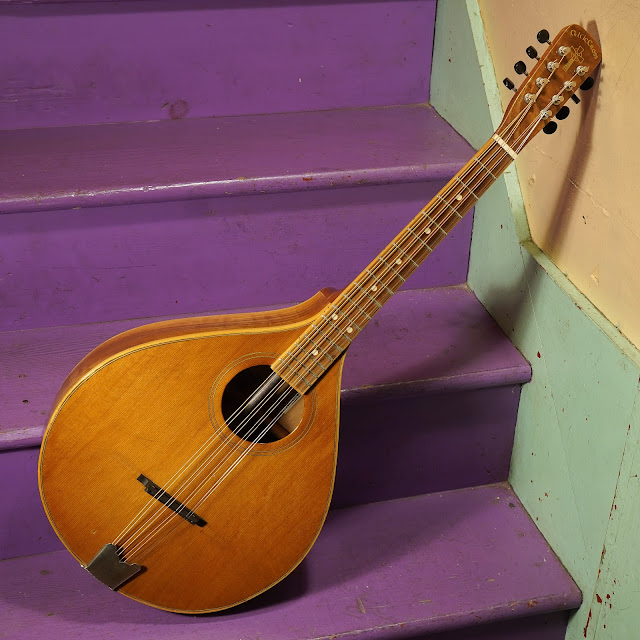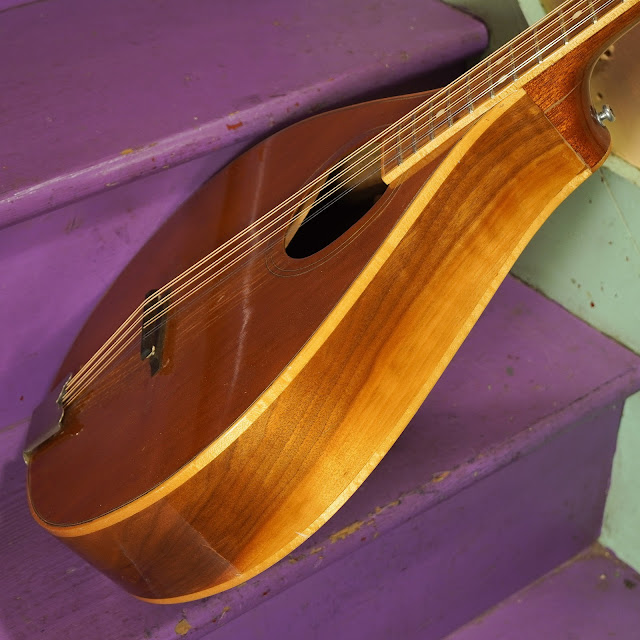2002 Celtic Cross (Neil Russell) Octave Mandolin
Celtic Cross instruments were built by Mr. Neil Russell in Victoria, British Columbia. He started-out building a number of Celtic-style, mandolin-family instruments like this one but then moved-on to solely building hollowneck Hawaiian guitars (Weissenborn-style). I have no idea what happened to him but he doesn't have a presence on the web anymore despite many of his instruments being out there in the world for all to see.
Anyhow, this one arrived a bit down on its luck (octave mandolins are hard to build for the long haul, folks) and my guy Jose leveled/dressed the frets a month ago and then it sat and marinated until I had a little time to spare to finish-up the work on it. Post-repairs, it has a beautiful, lingering sound and is perfectly suited to Celtic session work but would also make a good old-time picker.
I strung it up in unison stringing (like most octave mandolins) but I think it could also sound gorgeous with octave stringing like a bouzouki for chordal backing work. It needs to have fairly light strings on it as the neck is quick and fast and won't take the heavy gauges like you might find in a D'Addario pack of strings for an octave mando.
Repairs included: a fret level/dress, internal support rod added, replacement adjustable bridge fit, new tuners fit, side dots added, minor fill for back cracks, cleaning, and setup.
- Weight: 3 lbs 2 oz
- Scale length: 21 1/8
- Nut width: 1 3/8"
- Neck shape: slim C
- Board radius: 14"
- Body width: 13 1/4"
- Body depth: 3 1/4"
- Top wood: solid cedar w/maple binding
- Back & sides wood: not sure -- solid mahogany or walnut?
- Bracing type: x
- Bridge: ebony adjustable
- Fretboard: walnut or...?
- Neck wood: mahogany
- Action height at 12th fret: 1/16" overall (fast, spot-on)
- String gauges: 40w, 30w, 20w, 11 for GDAE tuning
- Truss rod: non-adjustable
- Neck relief: tiny relief at pitch (~1/64")
- Fret style: medium-lower
Condition notes: it has a couple of hairline cracks along the center strip in the back that have been repaired in the past and also filled. It's right along the backstrip so cleats couldn't be added -- but they're stable. The top was showing signs of fatigue at the soundhole so I added a 1/2" dowel reinforcement bar to the center of the body from neckblock to endblock. This takes the compression force off of the soundhole and as a bonus the instrument has more sustain and feels more "awake." Compression warp at the soundhole is very common on octave mandolins as many builders under-build the neckblock area. There are some dings on the top and the neck/fretboard itself has a hair of warp in it -- but said warp is ameliorated by a heavy-handed level/dress job of the frets so, in effect, it plays with a "straight neck" and is quick and easy under the fingers.
It comes with: sorry, no case.
Consignor tag: LCL




















Comments